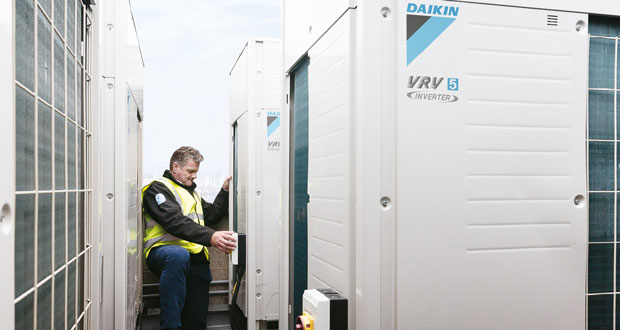BUILDING REGULATIONS
Beyond the F-gas regulations, facilities managers must also navigate an increasingly complex landscape of building standards and certifications. Each has its own focus and data requirements, making it essential to understand which is most relevant for specific building applications, uses and sizes.
The most widely known and used is the Building Research Establishment Environmental Assessment Method (BREEAM), which remains one of the most widely recognised standards globally. Its upcoming Version 7 update places stronger emphasis on carbon reduction and climate resilience, with growing focus on Environmental Product Declarations (EPDs).
EPDs provide detailed and verified data about the environmental impact of a product throughout its lifecycle. This includes everything from raw material extraction and manufacturing to usage and end-of-life disposal or recycling.
The importance of these independently verified declarations cannot be overstated. They offer facilities managers objective, credible insights into products’ true performance, enabling more informed procurement decisions that align with carbon reduction goals.
NABERS (National Australian Built Environment Rating System), is another standard that is becoming more popular and will continue in prominence now that it has been incorporated by the Chartered Institution of Building Services Engineers (CIBSE) for use in the UK. It measures buildings’ environmental performance across energy, water, indoor environment, and waste management using a star rating system.
NABERS Energy ratings are particularly impactful for decarbonisation, as they promote the reduction of operational energy use in buildings and encourage renewable energy adoption. Many facilities managers are now using these ratings to set tangible goals for emission reductions.
Finally, the UK Net Zero Carbon Buildings Standard provides the most comprehensive framework for achieving true net zero carbon emissions in the built environment. Unlike some other standards, it addresses both operational and embodied carbon – a holistic approach that aligns with the larger climate goals.
This standard essentially serves as a roadmap for buildings to meet global climate goals. It provides measurable targets for developers, designers, and property managers to achieve carbon-neutral buildings.
FUTURE REQUIREMENTS
Decarbonisation is very much a strategic issue. It enables organisations to stay ahead of the regulatory curve and obtain competitive advantage – and can improve brand reputation. With the regulatory landscape evolving rapidly, partnering with knowledgeable suppliers has become essential for facilities managers seeking to navigate these changes effectively.
For example, data-powered intelligence is becoming increasingly crucial in bridging the gap between net zero ambition and action. Working with a supplier that can provide valuable insights on embodied carbon, operational performance, and analytical data can help faculties managers to optimise energy efficiencies throughout a system’s lifetime.
The path to achieving net zero by 2050 requires immediate action across all sectors, with the built environment playing a particularly crucial role. For facilities managers, understanding the evolving HVAC legislation and partnering with knowledgeable suppliers can transform regulatory compliance from a challenge into an opportunity – one that delivers operational efficiencies, cost savings, and enhanced reputation alongside vital environmental benefits.






